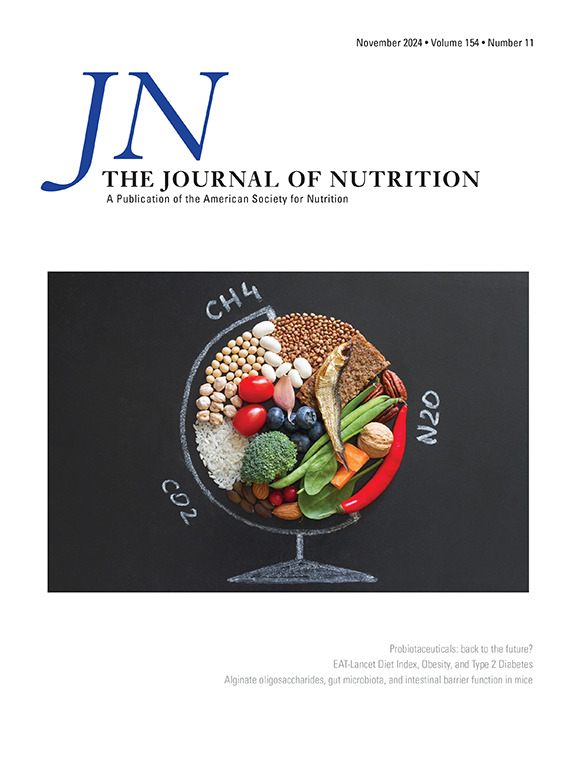将富含维生素 C 的番石榴与绿豆粉一起食用可减少贫血,增加血红蛋白,但不会增加铁储存:印度儿童食物间强化的随机对照试验。
IF 3.7
3区 医学
Q2 NUTRITION & DIETETICS
引用次数: 0
摘要
背景:在含铁主食中添加富含维生素 C 的水果可能是提高铁的生物利用率从而减少儿童缺铁性贫血的有效策略:作为学校供餐计划的一部分,我们旨在评估食用含或不含番石榴果实的绿豆膳食对儿童体内铁储存、血红蛋白浓度和贫血的影响:我们对印度北部哈里亚纳邦一个农村社区的 6 至 10 岁学龄儿童(人数=200;46% 贫血,71% 缺铁)进行了为期 7 个月的随机对照试验。儿童被分配到两个治疗组,每天只吃绿豆豆渣(含铁 3.0 毫克;维生素 C 与铁的摩尔比为 0.5:1),或绿豆豆渣加新鲜番石榴(含铁 3.2 毫克;维生素 C 170 毫克;摩尔比为 18:1)。每天在学校监督下供餐。主要结果是体内铁储存量,血红蛋白浓度和其他铁指标是次要结果:结果:每天食用绿豆豆浆和番石榴并不能全面改善体内的铁储存量(平均治疗效果:0.65 毫克/千克体重;95% CI:-0.34,1.63;P=0.197)。不过,与只食用绿豆粉的儿童相比,番石榴组儿童的血红蛋白浓度增加幅度更大(3.7 克/升;95% CI:1.6,5.6;P=0.001),贫血症(-51%;95% CI:-74,-10;P=0.022)和缺铁性贫血症(-56%,95% CI:-83,13;P=0.087)的发病率下降幅度更大。这些影响在研究开始时缺铁的儿童中更为明显:结论:在含有适量铁元素的绿豆膳食中添加番石榴可增加血红蛋白并减少贫血,但番石榴所提供的额外铁吸收量不足以同时增加体内的铁储存量。在含铁的学校膳食中加入富含维生素 C 的水果进行食物间强化,可能有助于减轻儿童贫血的负担。该试验已在 https://clinicaltrials.gov/ct2/show/NCT01191463 上注册。本文章由计算机程序翻译,如有差异,请以英文原文为准。
Vitamin C-Rich Guava Consumed with Mungbean Dal Reduces Anemia and Increases Hemoglobin but not Iron Stores: A Randomized Controlled Trial of Food-to-Food Fortification in Indian Children
Background
Adding vitamin C-rich fruit to staples containing iron could be an effective strategy to improve iron bioavailability and thereby reduce iron-deficiency anemia in children.
Objectives
We aimed to assess the effect of consuming a mungbean-based meal with or without guava fruit on body iron stores, hemoglobin concentration, and anemia of children as part of a school feeding program.
Methods
We conducted a 7-mo randomized, controlled trial with 6- to 10-y-old school children (n = 200; 46% anemic, 71% iron-deficient) from a rural community in Haryana, North India. Children were assigned to 2 treatment groups to daily receive either a meal of mungbean dal only (3.0 mg iron; vitamin C:iron molar ratio ∼0.5:1), or mungbean dal with fresh guava (3.2 mg iron; ∼170 mg vitamin C; molar ratio ∼18:1). Meals were served every school day under supervision. The primary outcome was body iron stores, whereas concentrations of hemoglobin and other iron indicators were secondary outcomes.
Results
Daily consumption of mungbean dal along with guava did not result in an overall improvement of body iron stores [mean treatment effect: 0.65 mg/kg body weight; 95% confidence interval (CI): −0.34, 1.63; P = 0.197]. However, compared with children who consumed mungbean dal only, children in the guava group showed a larger increase in hemoglobin concentration (3.7 g/L; 95% CI: 1.6, 5.6; P = 0.001), and a larger drop in the prevalence of anemia (−51%; 95% CIs: −74, −10; P = 0.022) and iron-deficiency anemia (−56%, 95% CI: −83, 13; P = 0.087). These effects were more pronounced in children who were iron deficient at study start.
Conclusions
Addition of guava to a mungbean-based meal containing a moderate amount of iron increased hemoglobin and reduced anemia but did not provide enough additional absorbed iron to also increase body iron stores. Food-to-food fortification by inclusion of vitamin C-rich fruits in iron-containing school meals may help alleviate the burden of anemia in children.
Trial registration number
This trial was registered at https://clinicaltrials.gov/ct2/show/NCT01191463.
求助全文
通过发布文献求助,成功后即可免费获取论文全文。
去求助
来源期刊

Journal of Nutrition
医学-营养学
CiteScore
7.60
自引率
4.80%
发文量
260
审稿时长
39 days
期刊介绍:
The Journal of Nutrition (JN/J Nutr) publishes peer-reviewed original research papers covering all aspects of experimental nutrition in humans and other animal species; special articles such as reviews and biographies of prominent nutrition scientists; and issues, opinions, and commentaries on controversial issues in nutrition. Supplements are frequently published to provide extended discussion of topics of special interest.
 求助内容:
求助内容: 应助结果提醒方式:
应助结果提醒方式:


